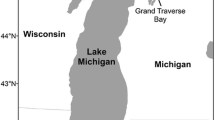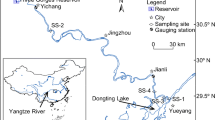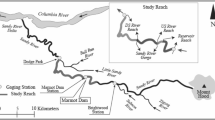Abstract
Despite the ecological importance of the estuaries draining into the Caspian Sea, there is insufficient information about their fish habitats. The Tajan River is an excellent habitat for native and migratory fish species, including Caspian whitefish. Even with the environmental and economic value of Caspian whitefish, the vital parameters of this species have not been quantified and modeled, primarily since the effect of upstream pollution load on their livable volume has not been investigated. In this study, we investigate the suitability of the estuary for spawning and the habitat of Caspian whitefish based on their vital need for dissolved oxygen and temperature. We determined the share of each pollution source around the Tajan River. Then using these data, we calculate the receiving pollution load into the estuary using the QUAL2K model. In the next step, we developed the CE-QUAL-W2 model and added the critical spawning and habitat parameters of Caspian whitefish to the model equations. Finally, the habitable volume for Caspian whitefish is identified, and we examined the conditions of the Tajan estuary under three different scenarios. The results showed that in the period from March 10 to April 10, a suitable volume of the estuary has the conditions for the migration of Caspian white fish. However, the bed layer has suitable conditions for the growth of white fish eggs from March 22, so the eggs released before this date are destroyed. In addition, reducing the BOD load of urban and rural sources has the highest impact on the water quality in the estuary. It can significantly improve the living and spawning conditions of Caspian whitefish.
Article Highlights
-
We identified all sources of pollutants along the Tajan River to estimate the load and share of each pollution source discharging into the estuary.
-
We developed the QUAL2K model to simulate the water quality of the Tajan River.
-
We developed the two-dimensional model of the estuary by adding the vital biological parameters of the Caspian whitefish to the model equation.
-
We calculated the habitable and spawning volume of Caspian whitefish in the estuary according to the contribution of upstream pollutant sources.








Similar content being viewed by others
References
Ahmad Kamal N, Muhammad N, Abdullah J (2020) Scenario-based pollution discharge simulations and mapping using integrated QUAL2K-GIS. Environ Pollut 259:113909. https://doi.org/10.1016/j.envpol.2020.113909
Allen GP, Salomon JC, Bassoullet P, Du Penhoat Y, de Grandpré C (1980) Effects of tides on mixing and suspended sediment transport in macrotidal estuaries. Sed Geol 26(1–3):69–90. https://doi.org/10.1016/0037-0738(80)90006-8
Babakhani Z, Sarai Tabrizi M, Babazadeh H (2019) Determination of river self-purification capacity using Qual2kw mode case study: divandare river. Iran J Ecohydrol 6(3):673–684. https://doi.org/10.22059/ije.2019.274432.1031
Barletta M, Lima ARA, Costa MF, Dantas DV (2017) Estuarine ecoclines and the associated fauna: ecological information as the basis for ecosystem conservation. In: Finkl C, Makowski C (eds) Coastal wetlands: alteration and remediation. Coastal Research Library, vol 21. Springer, Cham. https://doi.org/10.1007/978-3-319-56179-0_16
Barletta M, Lima ARA (2019) Systematic review of fish ecology and anthropogenic impacts in South American estuaries: setting priorities for ecosystem conservation. Front Mar Sci 6:237. https://doi.org/10.3389/fmars.2019.00237
Blaber SJ (2008) Tropical estuarine fishes: ecology, exploitation and conservation. Wiley
Blaber SJ (2000) Tropical estuarine fishes: ecology, exploitation and conservation. Blackwell Science, Oxford
Booij NRRC, Ris RC, Holthuijsen LH (1999) A third-generation wave model for coastal regions: 1. Model description and validation. J Geophys Res Oceans 104(C4):7649–7666
Bowen JD, Harrigan NB (2018) Water quality model calibration via a full-factorial analysis of algal growth kinetic parameters. J Mar Sci Eng 6(4):137
Boyacioglu H, Alpaslan MN (2008) Total maximum daily load (TMDL) based sustainable basin growth and management strategy. Environ Monit Assess 146:411–421. https://doi.org/10.1007/s10661-007-0087-3
Bui HH, Ha NH, Nguyen TND, Nguyen AT, Pham TTH, Kandasamy J, Nguyen TV (2019) Integration of SWAT and QUAL2K for water quality modeling in a data scarce basin of Cau River basin in Vietnam. Ecohydrol Hydrobiol 19(2):210–223
Chapra SC (2003) Engineering water quality models and TMDLs. J Water Resour Plan Manag 129(4):247–256. https://doi.org/10.1061/(ASCE)0733-9496(2003)129:4(247)
Chen XY, Chau KW, Busari AO (2015) A comparative study of population-based optimization algorithms for downstream river flow forecasting by a hybrid neural network model. Eng Appl Artif Intell 46:258–268
Chi L, Song X, Yuan Y, Wang W, Zhou P, Fan X et al (2017) Distribution and key influential factors of dissolved oxygen off the Changjiang River Estuary (CRE) and its adjacent waters in China. Mar Pollut Bull 125(1–2):440–450
Cole TM, Wells SA (2006) CE-QUAL-W2: a two-dimensional, laterally averaged, hydrodynamic and water quality model, version 3.5 instruction report EL-06-1. US Army Engineering and Research Development Center, Vicksburg, MS
Cole T (2021) Overview of data preparation in CE-QUAL-W2: a two-dimensional, laterally averaged, hydrodynamic and water quality model, version 4.5, user manual part 1, introduction, ed. by S. Wells, Department of Civil and Environmental Engineering, Portland State University, Portland, OR.
da Mata PP, da Costa KG, Perônico C et al (2019) Development of environmental effects monitoring protocol in Brazil: a fish guide study of three river estuaries. Environ Monit Assess 191(11):658. https://doi.org/10.1007/s10661-019-7860-y
Day JH (1980) What is an estuary. S Afr J Sci 76(5):198
Elliott M, McLusky DS (2002) The need for definitions in understanding estuaries. Estuar Coast Shelf Sci 55(6):815–827
Elliott M, Mander L, Mazik K, Simenstad C, Valesini F, Whitfield A, Wolanski E (2016) Ecoengineering with ecohydrology: successes and failures in estuarine restoration. Estuar Coast Shelf Sci 176:12–35
ESRI 2011. ArcGIS Desktop: Release 10.
Faryadi S, Shahedi K, Nabatpoor M (2013) Investigation of water quality parameters in tadjan river using multivariate statistical techniques. J Watershed Manage Res 3(6): 75–92. https://www.sid.ir/en/journal/ViewPaper.aspx?id=333581
Garcia DAZ, Occhi TVT, Agostinho ÂA, Alves GHZ, Brito MFG, Casimiro ACR, Couto TBA, Cunico AM, Jarduli LR, Lima-Junior DP, Magalhães ALB, Novaes JLC, Orsi ML, Pelicice FM, Petrere-Junior M, Rodrigues FL, Sampaio FDF, dos Santos VLM, Soares BE, Tonella LH, Zuanon JAS, Vitule JRS (2022) More of the same: new policies continue fostering the use of non-native fish in Brazil. Environ Conserv 49(1):4–7
Geyer WR, MacCready P (2014) The estuarine circulation. Ann Rev Fluid Mech 46:175–197. https://doi.org/10.1146/annurev-fluid-010313-141302
Ghasemi M, Zamani H, Hosseini SM, Haghighi Karsidani S, Bergmann SM (2014) Caspian white fish (Rutilus frisii kutum) as a host for Spring Viraemia of Carp Virus. Vet Microbiol 170(3–4):408–413. https://doi.org/10.1016/j.vetmic.2014.02.032
Gonzalez LA, Quigg A, Steichen JL et al (2021) A new approach to functionally assess estuarine fish communities in response to hydrologic change. Estuaries Coasts 44:1118–1131. https://doi.org/10.1007/s12237-020-00824-y
Gupta VK, Ali I (2013) Environmental water: advances in treatment, remediation and recycling. Newnes
Haddout S, Maslouhi A, Baimik I, Igouzal M, Marah H (2019) Two-dimensional modeling of the vertical circulation of salt intrusion in the Sebou estuary under different hydrological conditions. ISH J Hydraulic Eng 25(2):170–187. https://doi.org/10.1080/09715010.2017.1391134
Hadavi S, Hassanzadeh Hosseinabadi H (2018) Identification of pollution sources in Tajan catchment to monitor water quality (Case study: Sari city). International Conference on Society and Environment, Tehran. https://en.civilica.com/doc/815725/
Halliday SJ, Wade AJ, Skeffington RA, Neal C, Reynolds B, Rowland P, Neal M, Norris D (2012) An analysis of long-term trends, seasonality and short-term dynamics in water quality data from Plynlimon, Wales. Sci Total Environ 434:186–200
HEC-GeoRAS User’s manual: an extension for support of HEC-RAS using ArcGIS, 2005. US Army Corps of Engineering Hydrologic Engineering Center, Davis.
HEC-RAS, “Hydraulic Reference Manual,” US Army Corps of Engineers, 2008. Hydrologic Engineering Center, Davis Version 4.0.
Khodadadi A, Hayaty M, Tavakoli Mohammadi MR, Partani S (2013) Investigation of polluted zones by lead in north west of iran, 2nd international conference & exhibition of waste management, recycling & biomass, Tehran. https://doi.org/10.1051/e3sconf/20130141007
McLusky DS, Elliott M (2007) Transitional waters: a new approach, semantics or just muddying the waters? Estuar Coast Shelf Sci 71(3–4):359–363
Nikakhtar M, Rahmati SH (2020) Simulating of surface water quality using QUAL2Kw (Ardak River, Khorasan Razavi Province).
Orton TG, Mallawaarachchi T, Pringle MJ, Menzies NW, Dalal RC, Kopittke PM et al (2018) Quantifying the economic impact of soil constraints on Australian agriculture: a case-study of wheat. Land Degrad Dev 29(11):3866–3875
Pelletier GJ, Chapra SC (2005) QUAL2Kw theory and documentation (version 5.1), a modeling framework for simulating river and stream water quality. http://www.ecy.wa.gov/programs/eap/models/.
Potter IC, Tweedley JR, Elliott M, Whitfield AK (2015) The ways in which fish use estuaries: a refinement and expansion of the guild approach. Fish Fish 16(2):230–239. https://doi.org/10.1111/faf.12050
Ramos-Fuertes A, Palau A, Dolz J (2018) Application of a two-dimensional water quality model (CE-QUAL-W2) to the thermal impact assessment of a pumped-storage hydropower plant project in a mountainous reservoir (Matalavilla, Sil River, Spain). Advances in Hydroinformatics . Springer Water. Springer, Singapore. https://doi.org/10.1007/978-981-10-7218-5_20
Roushan Tabari M, Takmilian H, Sabkara J, Rouhi AAG, Rostamian MT (2003) Distribution of zooplanktons in the southern caspian sea. Iran Sci Fish J 12(3):83–96
Santiago-Collazo FL, Bilskie MV, Hagen SC (2019) A comprehensive review of compound inundation models in low-gradient coastal watersheds. Environ Model Softw 119:166–181
Savenije HHG (2015) Prediction in ungauged estuaries: an integrated theory. Water Resour Res 51(4):2464–2476. https://doi.org/10.1002/2015WR016936
Shapoori M, Javanshir A, Jamili S, Fallahi M, Changizi R (2009) Phytoplankton primary production and distribution in a south caspian sea basin case study in Tajan River Estuary. Res J Environ Sci 3: 1–15. https://scialert.net/abstract/?doi=rjes.2009.1.15
Shchepetkin AF, McWilliams JC (2005) The regional oceanic modeling system (ROMS): a split-explicit, free-surface, topography-following-coordinate oceanic model. Ocean Model 9(4):347–404
Statistical Center of Iran (2017) Census of population and housing, 2017. (in Persian)
Taheri Soodjani T, Barati KH, Shayan Nejad M (2016) Introduction of basic equations of Qual2kw model and practical guide of the model. J Water Sustain Dev 2(2):35–42. https://doi.org/10.22067/jwsd.v2i2.47011
U.S. Geological Survey (2017) USGS 3D elevation program digital elevation model. https://elevation.nationalmap.gov. Accessed 7 Jun 2017
Von Stackelberg NO, Neilson BT (2014) Collaborative approach to calibration of a riverine water quality model. J Water Resour Plan Manag 140(3):393–405
Wei X, Kumar M, Schuttelaars HM (2017) Three-dimensional salt dynamics in well-mixed estuaries: influence of estuarine convergence, coriolis, and bathymetry. J Phys Oceanogr 47(7):1843–1871. https://doi.org/10.1175/JPO-D-16-0247.1
Wells SA (2021) CE-QUAL-W2: a two-dimensional, laterally averaged, hydrodynamic and water quality model, version 4.5, user manual part 1, introduction. Department of Civil and Environmental Engineering, Portland State University, Portland, OR
Whitfield AK (1990) Life-history styles of fishes in South African estuaries. Environ Biol Fishes 28(1):295–308
Whitfield AK (1999) Ichthyofaunal assemblages in estuaries: a South African case study. Rev Fish Biol Fisheries 9(2):151–186
Whitfield AK (2005) Preliminary documentation and assessment of fish diversity in sub-Saharan African estuaries. Afr J Mar Sci 27(1):307–324
Whitfield AK (2017) The role of seagrass meadows, mangrove forests, salt marshes and reed beds as nursery areas and food sources for fishes in estuaries. Rev Fish Biol Fisheries 27(1):75–110
Yáñez-Arancibia A, Anezcua F, Day Jr JW (1980) Fish community structure and function in Terminos Lagoon, a tropical estuary in the Gulf of Mexico. In: Kennedy V (ed) Estuarine perspectives. Academic Press, New York, pp 465–482. https://doi.org/10.1016/B978-0-12-404060-1.50044-7
Yáñez-Arancibia A, Lara-Domınguez AL, Pauly Y (1994) Coastal lagoons as fish habitats. In: Kjerfve K (ed) Coastal lagoon processes. Elsevier, Amsterdam, pp 363–376
Yanez-Arancibia A, Day JW, Twilley RR, Day RH (2014) Mangrove swamps: sentinel ecosystem in front of the climatic change, Gulf of Mexico. Madera y Bosques 20(5):39–75
Ye H, Guo S, Li F et al (2013) Water quality evaluation in Tidal River reaches of Liaohe River Estuary, China using a revised QUAL2K model. Chin Geogr Sci 23:301–311. https://doi.org/10.1007/s11769-013-0586-9
YoosefDoost A, Karrabi M, Rezazadeh N et al (2020) Development of the delta-normal stress combining CE-QUAL-W2 as a novel method for spatio-temporal monitoring of water quality in Karkheh Dam Reservoir. Environ Monit Assess 192:312. https://doi.org/10.1007/s10661-020-08295-1
Zallaghi MARYAM, Afrous A (2019) Qualitative simulation of nitrate and phosphate along the Dez River using QUAL2KW model. J Soil Water Res 50(90):2099–2111
Zscheischler J, Rogga S, Lange A (2018) The success of transdisciplinary research for sustainable land use: individual perceptions and assessments. Sustain Sci 13(4):1061–1074. https://doi.org/10.1007/s11625-018-0556-3
Funding
The authors did not receive support from any organization for the submitted work.
Author information
Authors and Affiliations
Corresponding author
Ethics declarations
Conflict of interest
The authors have no relevant financial or non‑financial interests to disclose.
Rights and permissions
Springer Nature or its licensor holds exclusive rights to this article under a publishing agreement with the author(s) or other rightsholder(s); author self-archiving of the accepted manuscript version of this article is solely governed by the terms of such publishing agreement and applicable law.
About this article
Cite this article
Saeidi, P., Mehrdadi, N., Karbassi, A. et al. Integrated River-Estuary Modeling to Assess Spawning and Habitation Area for Caspian WhiteFish in Response to Upstream Pollution Sources (Case Study: Tajan River Estuary). Int J Environ Res 16, 93 (2022). https://doi.org/10.1007/s41742-022-00475-w
Received:
Revised:
Accepted:
Published:
DOI: https://doi.org/10.1007/s41742-022-00475-w




